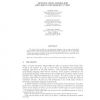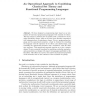CSFW
2010
IEEE
14 years 9 months ago
2010
IEEE
Abstract—Layout randomization is a powerful, popular technique for software protection. We present it and study it in programming-language terms. More specifically, we consider ...
AOSD
2007
ACM
14 years 9 months ago
2007
ACM
Most approaches to programming language extensibility have worked by pairing syntactic extension with semantic extension. We present an approach that works through a combination o...
LICS
1989
IEEE
14 years 9 months ago
1989
IEEE
We explore ideal models for a programming language with recursive polymorphic types, variants of the model studied by MacQueen, Plotkin, and Sethi. The use of suitable ideals yiel...
DBPL
1989
Springer
14 years 9 months ago
1989
Springer
In the process of developing an Information System, one passes through stages that include requirements gathering, design specification, and software implementation. The purpose ...
LPAR
1992
Springer
14 years 9 months ago
1992
Springer
We describe some of the techniques which have been used to implement METATEM, a programming language based on temporal logic, and address problems such as non-determinism and loopi...
TACS
1994
Springer
14 years 9 months ago
1994
Springer
Abstract. We have designed a programming logic based on an integration of functional programming languages with classical set theory. The logic merges a classical view of equality ...
ICCL
1992
IEEE
14 years 9 months ago
1992
IEEE
Multiparadigm programming is a term used to describe a style of software development that makes use of facilities originally designed in support of a number of di erent programmin...
ESOP
1994
Springer
14 years 9 months ago
1994
Springer
Scientists and engineers must ensure that physical equations are dimensionally consistent, but existing programming languages treat all numeric values as dimensionless. This paper ...
HOPL
1993
14 years 9 months ago
1993
The programming language, Prolog, was born of a project aimed not at producing a programming language but at processing natural languages; in this case, French. The project gave r...
DBPL
1993
Springer
14 years 9 months ago
1993
Springer
A class of database programs exist which are required to operate over an infinite number of types; included in this class are object browsers and query tools. The types over which...






